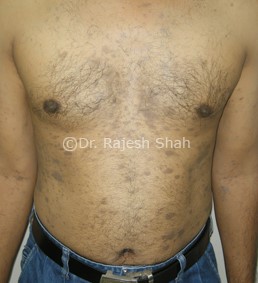Lichen Planus - its Signs and Symptoms
Lichen Planus is a long-standing, inflammatory skin disorder which you can find affecting many individuals throughout the world. This obstinate skin condition has bemused not only the affected individuals but also several medical practitioners equally. Lichen planus is a recurring, non-contagious, and non-allergic skin disease. It affects people of any skin color, gender, and race. You may find only a little help from the current medical faculty to tackle this chronic skin ailment. Fortunately, homeopathy, which is an effective alternative medicine experiencing rapid growth, offers a definite, safe, and promising Lichen Planus treatment.
The exact cause of Lichen Planus is not yet known. This skin disorder tends to affect various areas of the body, such as skin, scalp, nails, genitals oral mucosa, and tongue. But, the probability that it would affect all these areas of the body at once is less. Often, Lichen Planus happens to reoccur after a period of some years or even months. The frequency of the occurrence of Lichen Planus in females is more as compared to that in the males. However, the occurrence of lichen planus in kids is rare and uncommon. Of the total population, more than 1.9% is known to be affected by this skin ailment.
See the typical lesions of lichen planus on the skin in this photo. Get a larger and better view of this photo by clicking it.
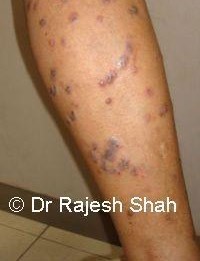 Signs & Symptoms Of Lichen Planus:
Signs & Symptoms Of Lichen Planus:
There are certain symptoms that indicate lichen planus. Some of the common signs and symptoms of lichen planus are as mentioned below.
-
Irregular or round raised eruptions (They are a slightly raised above your skin)
-
Brown, black, or pinkish lesions
-
Itching present at the affected area/rash.
-
Bumps or purplish lesions having flat tops on your genitals or skin.
-
Thin white-colored lines over the rash
-
Lichen planus in mouth displays lacy-whitish lesions which may be accompanied by burning sensation or pain.
-
Lesions that occur & spread over the skin of the body in a few months or weeks.

Commonly Affected Parts By Lichen Planus:
Lichen Planus largely and prominently affects the skin of the body. Besides the skin, it may affect other areas of your body, such as the scalp, mouth (including the tongue, gums, & palate), nails, or genitals (penis, vulva, glans). One or more of these body areas may get affected by this skin disorder. It’s not necessary that all these mentioned body areas would get affected by lichen planus. In females, lichen planus could affect vagina or vulva, while in males it may affect penis’ glans. The fact is that the more the body areas affected, the more it is difficult to treat lichen planus. Besides this, lichen planus in the mouth and genital lichen planus are more difficult to treat as compared to lichen planus affecting the body skin. When lichen planus affects your scalp, it may cause scarring and may make you suffer from permanent hair loss, which, of course, is quite difficult to treat.
Lichen Planus and Hepatitis C:
Certain latest medical studies have revealed the occurrence of lichen planus along with a rare type of Hepatitis C. However, the exact causative factor or exact connection is not yet discovered between these two diseases. It is important to note that the patients of Hepatitis C possess some vulnerability to develop the discomfort due to lichen planus, however, the reverse is not true.
The typical textbook description goes:
The typical appearance of lichen planus occurs with polygonal eruptions which are flat-topped and shiny. You may have few or many spots of this skin disorder on your body that often occur bilaterally symmetrical. The eruptions may be small, thick, oily or rough to touch and appear dirty at times.
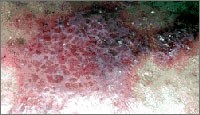
This is a typical appearance of Lichen Planus as described as Wickham's striae.
(Refer to this photo)
Under The Microscope:
Often, the microscopic view of the Lichen Planus tissues is not known to the patients. Below is the microscopic view of it.
 Sometimes, you may see eruptions of Lichen Planus present at a scratch mark’s line or site of injury. This is called Koebner’s phenomenon. It may affect genitals too. In male individuals, it may affect the glans, while in females it may affect the vulva.
Sometimes, you may see eruptions of Lichen Planus present at a scratch mark’s line or site of injury. This is called Koebner’s phenomenon. It may affect genitals too. In male individuals, it may affect the glans, while in females it may affect the vulva.
When the lichen planus affects the nails, they may become deformed. Some of the most common types of lichen planus are those affecting the skin, lichen planus in the mouth (i.e. oral lichen planus), and vaginal lichen planus. When the genital or oral mucosa gets affected by this skin disorder, the condition is often overlooked, reported quite late, or diagnosed wrongly. One of the rare types of lichen planus is the one affecting the food pipe (i.e. esophagus). Even though it is uncommon, some cases of this condition are reported at some organizations.
The best part is that all types of lichen planus respond to the homeopathic treatment for lichen planus very well. Homeopathy provides outstanding results when it is used to treat the lichen planus of skin, genitals, and mouth. So, you can say that homeopathy is an effective lichen planus cure safely without any side-effects.
Lichen Planus after stretch marks:
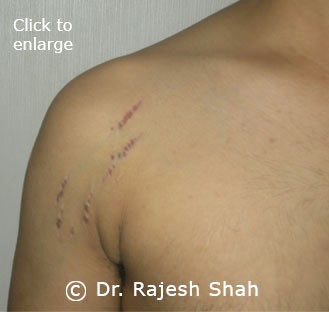
One of the recent cases of lichen planus recorded at Life Force had featured the occurrence of this skin condition after stretch marks on weight loss. Such an occurrence of lichen planus is called  Koebner phenomenon, which signifies the occurrence of lichen planus after your skin experiences trauma.
Click to see the large size photo

Before Treatment After Treatment
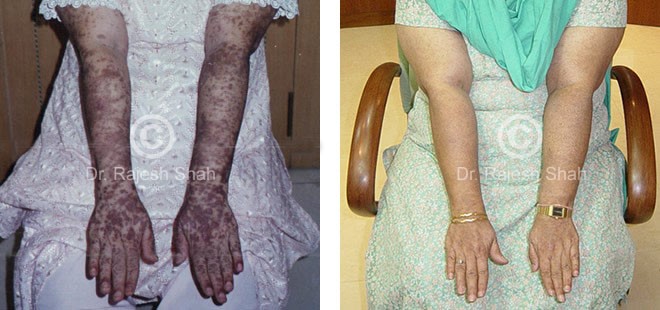
Causes of Lichen Planus
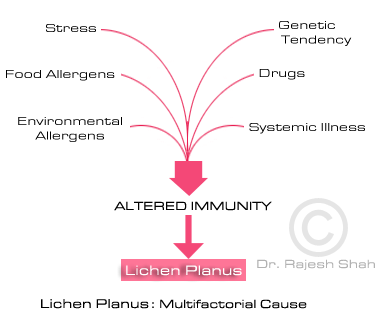
Lichen Planus is known to be an autoimmune disorder. Even though the exact lichen planus cause is not yet clear, there are certain triggers which are clinically found to cause the development of lichen planus. There are certain theories too which predict the cause of this skin condition. In some cases of lichen planus, there are obvious links that tend to be responsible. Some of them are as follows.
1. Modern Medicines
Non-steroidal anti-inflammatory painkillers (NSAID), amalgamated dental filling, antihypertensive drugs, and some other modern medicines are known to cause lichen planus. And, this skin condition may persist in spite of you stopping the use of these modern medicines. Here is a list of some of the common medicines which may lead to lichen planus.
2. Chemical Contact
One may also develop lichen planus after coming in the contact with certain types, such as paraphenylenediamine, Quinacrine, arsenic compounds, and certain metals like Bismuth, gold, and exposure to the light during photography development, etc.
3. Stress Leads to Lichen Planus
Detailed studies reveal that prolonged and intense emotional stress, such as traumatic childhood, disappointment, humiliation, anxiety, sadness, failure etc tend to initial lichen planus symptoms. Intense stress & anxiety stimulates certain immunological processes which lead to lichen planus. Even though the exact mechanism causing lichen planus is not yet understood, stress is a prominent trigger in several cases of lichen planus, but not all.

This crucial information is obtained from the study conducted at our center & it may not be present in other standard dermatological material.
4. Genetic Causes:
Hereditary is one of the prominent causes of lichen planus. We have noticed that this skin disorder runs in the family. But, it’s not a standard rule that if you happen to suffer from lichen planus, your kids too will get it. Also, it’s not an established rule that every lichen planus patient must have their relatives or parents the same disease. It’s been noticed that autoimmune disease like Lichen Planus present in a family then it is suggestive of a genetic link.
5. Allergic Component:
Certain medical studies have revealed that the presence of peculiar cells known as HLA A-3 cell markers indicates allergic & immunological links leading to Lichen Planus. It needs further investigations.

Lichen Planus Symptoms
Lichen Planus symptoms can surface on your skin, scalp, nails, mouth, or genitals in one or many ways as mentioned below.
-
Gradual onset
-
Irregular, round, thick, dark, flat-topped lesions on the skin
-
Eruptions can be brown, pink, reddish, or gray in color. They are rough, raised above the surface of the skin with mild scaling.
-
The appearance of the lesions is oily.
-
The lesions may bleed on scratching.
-
It may itch intensely or not itch at all.
-
The scratched or injured skin may experience the development of new lesions according to Koebner’s phenomenon.
-
The burning sensation occurs in the mouth while consuming spicy food.
-
Lichen planus affecting the nails may cause deformed, ridged nails.
-
Oral lichen planus (lichen planus in the mouth) comes with white streaks on your mouth’s mucosa, gums, and tongue. You may get ulcers, which may be mild or extensive, in any part of the mouth in the oral mucosa.
-
The occurrence of white streaks or ulcers on the prepuce, the shaft of penis, vagina, or vulva are symptoms of genital lichen planus, which is painful in both the sexes.
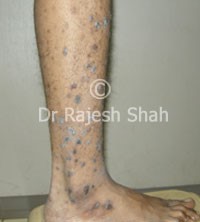
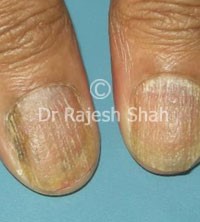
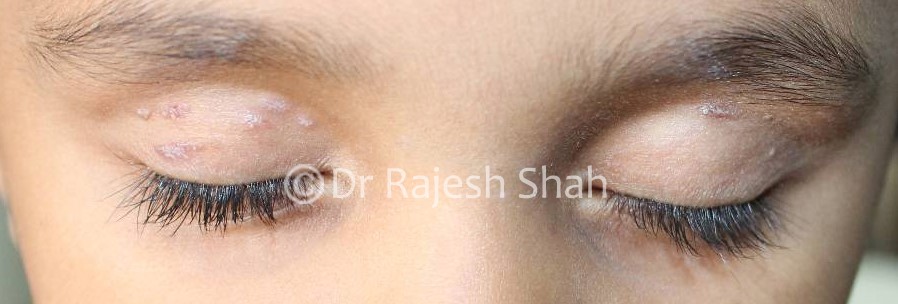
Diagnosis of Lichen Planus
Experienced eyes can easily diagnose Lichen Planus clinically. The typical appearance of skin lesions of this skin disorder as mentioned in the symptoms and their presence on the legs, nails, back, mouth, genitals, scalp, and on other parts of the body is crucial while diagnosing it. Lesions of lichen planus are peculiarly grayish, pinkish, or silvery eruptions of about 1 to 4 mm in size, round, irregular, or oval in shape, and itchy and scaly.
In the initial stages of this disease, the eruptions may resemble other skin ailments, such as psoriasis, candidiasis (in the mouth), atopic dermatitis, (mouth) aphthous ulcers, leukoplakia (affecting the mouth).
If you are doubtful about the diagnosis, a biopsy would help confirm the diagnosis. A biopsy is often suggested in the cases of the scalp and oral lichen planus. Besides this, lichen planus of nails too may resemble fungus infection affecting the nails or psoriatic nails. Clinically experienced eyes can easily differentiate and diagnose them appropriately in most cases.
Also, lichen planus affecting the scalp may present scarring by the time the affecting individual seeks treatment. So, going for a biopsy would help confirm the diagnosis of scalp lichen planus. Also, it may be associated with loss of hair known as alopecia areata.
Before Treatment After Treatment
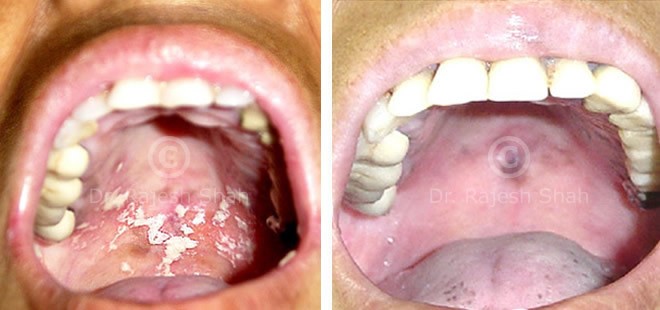
Before Treatment After Treatment
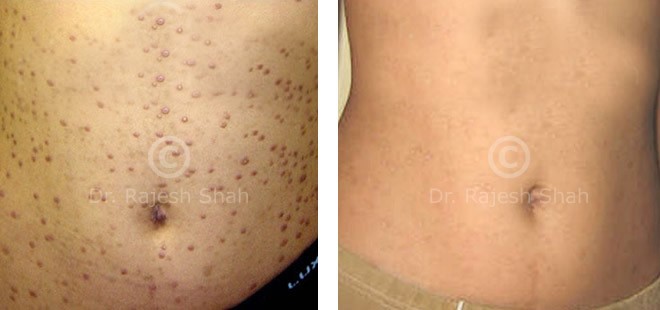
Homeopathy Treatment for Lichen Planus
Even though skin, scalp, mouth, nail, and genitals are affected by lichen planus, this skin disorder has its roots in the immune system which is regulated by certain genetic aspects. So, lichen planus treatment should focus on correcting and enhancing the immune system of the affected patient. If this is achieved, this skin disorder can be cured or treated for a long period. Superficially treated lichen planus by applying immunosuppressive medicines or cortisone will only result in resurfacing or relapsing of the disease as soon as the effect of such medicines is over.
Fortunately, homeopathy provides highly effective, scientifically documented, and research-proven treatment for tackling lichen planus. Unlike allopathic treatment where cortisone is used prominently, homeopathic treatment for lichen planus is excellently curative, longer-lasting, and quite safe. At Life Force, we have carried out research on Lichen Planus for more than two decades.
The Homeopathy Treatment
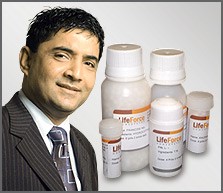
Lichen Planus is treated with homeopathy by considering the individual case study of every other patient, its cause, the affected body area, its spread, mindset, and emotional aspects, genetic tendencies, and many other factors specific to each patient. Homeopathic treatment for lichen planus is designed to correct the disturbed immune system of the patient and treating the disorder from within.
Dr. Rajesh Shah, M.D. has carried out outstanding research on Lichen Planus for more than 27 years. Patients of Lichen planus worldwide avail of his unique homeopathic treatment protocol to get relief. His research-based molecules have been granted the patent in the US & Europe. Today, patients from about 177 nations are under Dr. Shah’s treatment & care and it’s a world record. And, Lichen Planus cure is certainly possible now.
The Duration Of Treatment:
The span of homeopathic treatment for lichen planus may differ from patient to patient based on the factors mentioned below.
-
Affected body areas (whether its skin, scalp, mouth, nails, or genitals)
-
Duration of the disease
-
The extent of spread (whether only one part or many parts are affected)
-
Medication used previously (Extensive use of cortisone may delay recovery requiring more duration)
-
Associated ailments & general health of the patient
You may get a significant improvement in your condition in about three to five months of the treatment, depending on the extent of disease. The total duration of treatment may vary from 6 months to 2 years or even longer.
Various Other Treatment Options For Lichen Planus
Besides homeopathy, other treatment options available for treating lichen planus are mentioned below.
Why Homeopathy For Lichen Planus?
Homeopathy comes with several advantages when it comes to treating lichen planus. Some of the prominent benefits of using homeopathy for lichen planus are as mentioned below.
-
Homeopathy offers long-lasting recovery, instead of short-term or temporary.
-
It is completely safe, harmless, and free from any side-effects.
-
Homeopathy provides a highly effective treatment that has more than an 85% success rate.
-
It helps you achieve immune-correction, thus it offers deep healing.
Is The Treatment (& Its Duration) Different If Lichen Planus Affects Skin, Mouth, Genitals?
The duration of the homeopathic treatment & its scope largely depends on the location or areas affected by lichen planus. Lichen planus affecting the skin is comparatively easy to treat than oral or genital lichen planus. If an individual’s mouth, skin, and genitals all are affected by lichen planus then it is more difficult to treat. Multi-located lichen planus needs a longer duration of treatment. Also, medicines for lichen planus of skin are relatively different from that of lichen planus of mouth, nails, scalp, or genitals.
Lichen Planus Curability Test - More about Homeopathy
Before Treatment After Treatment
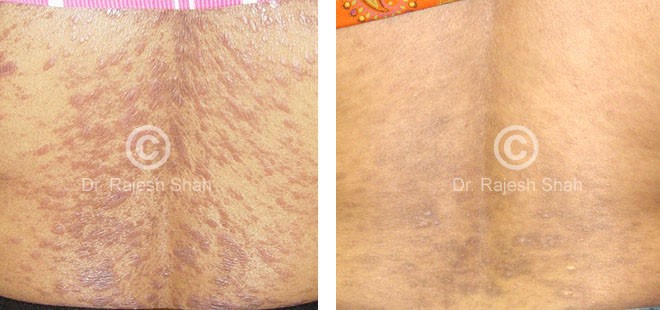
For more related case photos: Click Here
Read more on skin diseases homeopathic treatment
Oral Lichen Planus: Causes, Symptoms & Treatment
Oral lichen planus is a non-infectious, long-lasting inflammatory ailment that affects about 1% to 2% of the total general population of adult individuals. It results in lesions on the buccal mucosa, gums or/and tongue. Even though oral lichen planus predominantly tends to affect adult individuals who are more than 40 years old, children and younger adults too may suffer from it. It may affect either skin, nails, mouth, or genitals; or it may occur in combination or two or greater areas. In an extensive study of Lichen Planus at Life Force, not many cases of oral lichen planus in children have been noted.

Several medical studies state that autoimmunity plays a vital role in the pathogenesis of the oral lichen planus. This disorder can occur due to certain medicines, mechanical trauma, contact allergens present in toothpaste and other dental materials, viral infection, or certain unidentified agents.
Causes of Oral Lichen Planus
More than one lichen planus causes may be responsible for the occurrence of oral lichen planus. Often, certain drugs induce it. Also, stress plays a major role in triggering oral lichen planus. A genetic link is usually discovered in the family background. Even though oral lichen planus is regarded as pre-cancerous, it does not transform into cancer commonly. 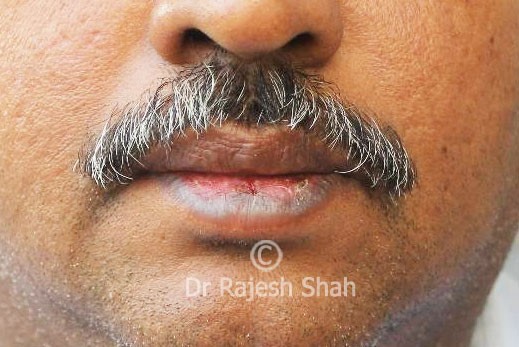 Certain common drugs that can induce lichen planus are mentioned below.
Certain common drugs that can induce lichen planus are mentioned below.
Symptoms of Oral Lichen Planus
Here are some of the common symptoms of oral lichen planus.
-
Most often, the onset of oral lichen planus is gradual and the affected individuals are unaware of its occurrence. Usually, during the routine checkup, the dentist or medical practitioner is able to identify the clinical changes occurring in the oral mucosa.
-
Usually, lesions of oral lichen planus tend to occur bilaterally.
-
Common signs & symptoms of this condition are sensitivity to spicy & hot foods, the presence of white or red patches on the gums and oral mucosa, rough sensation occurring in the mouth’s lining, or mouth ulcers.
-
Lesions of lichen planus in the mouth can be associated with brown, patchy melanin deposits occurring in the oral mucosa.

Treatment for Oral Lichen Planus:
Homeopathy is the quite effective and safest treatment for oral lichen planus. At Life Force, we have studied and worked on Lichen Planus for more than two decades, and we have treated most cases of this skin disorder successfully with homeopathy. Homeopathy for lichen planus is individualized treatment, quite safe, and highly effective.
Click here for Homeopathic treatment of oral LP
Click here for Testimonials of oral LP
Lichen Planus Pigmentosus Homeopathic Treatment
Lichen Planus Pigmentosa is a rare, uncommon skin disorder that is known to resemble Lichen Planus. It is characterized by oval grayish-brown marks that appear on the neck and face or limbs and trunk with the absence of the inflammatory phase.
Causes Of Lichen Planus Pigmentosa:
The exact cause of Lichen Planus Pigmentosa is not yet clear. Medical studies suggest that it may occur due to viral infections, UV rays, or certain applications to the skin, such as amla oil or mustard oil. Depending on the signs and symptoms of each affected person, the treatment of lichen planus pigmentosa is recommended.

Symptoms Of Lichen Planus Pigmentosa:
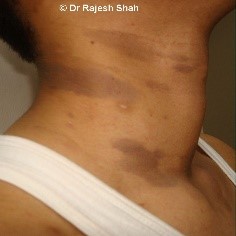 The Lichen Planus Pigmentosa affected skin turns dark, hyperpigmented, and dry and it spreads at a quite slow pace. Also, sporadic spots or some scattered spots or large patches may occur in bilateral symmetrical areas due to it. The patches of lichen planus pigmentosa can be big or small and they may spread or remain steady.
The Lichen Planus Pigmentosa affected skin turns dark, hyperpigmented, and dry and it spreads at a quite slow pace. Also, sporadic spots or some scattered spots or large patches may occur in bilateral symmetrical areas due to it. The patches of lichen planus pigmentosa can be big or small and they may spread or remain steady.
Generally, the affected individual suffers minimal or no itching. Unlike lichen planus, there are no elevated lesions or eruptions.
In about 30% of cases of lichen planus pigmentosus, genetic predisposition happens to be the cause.
It occurs in females and males equally, and it is more common in aged individuals and young adults.
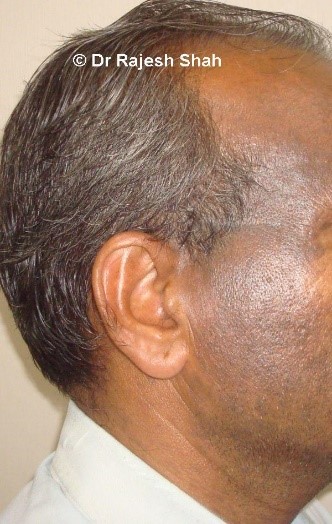
Lichen Planus pigmentosa does not make you suffer from any major discomfort, the prominent concern being cosmetic. Face, neck, and arms are some of the most commonly affected body areas.
Diagnosis:
Upon the proper examination of the affected skin, a trained physician can easily diagnose it. A biopsy can confirm it.
Conventional Treatment:
The conventional mode of treatment for lichen planus pigmentosa mostly includes the use of local cortisone.
Homeopathic Treatment:
Homeopathy is the most effective and safest treatment for lichen planus pigmentosa, which evolves over a long span of time and tends to respond slowly to treatment. Homeopathic treatment when followed for a long duration offers you outstanding results, regulates the spread of this skin condition, curbs the disease activity, and reverses the occurred hyperpigmentation to a certain extent. Even though complete recovery from hyperpigmentation may not happen in most of the cases of lichen planus pigmentosa, you can achieve great control over it. We have effectively treated and documents many cases of this skin condition that have achieved great control over lichen planus pigmentosa and, in some cases, definite recovery is observed.
